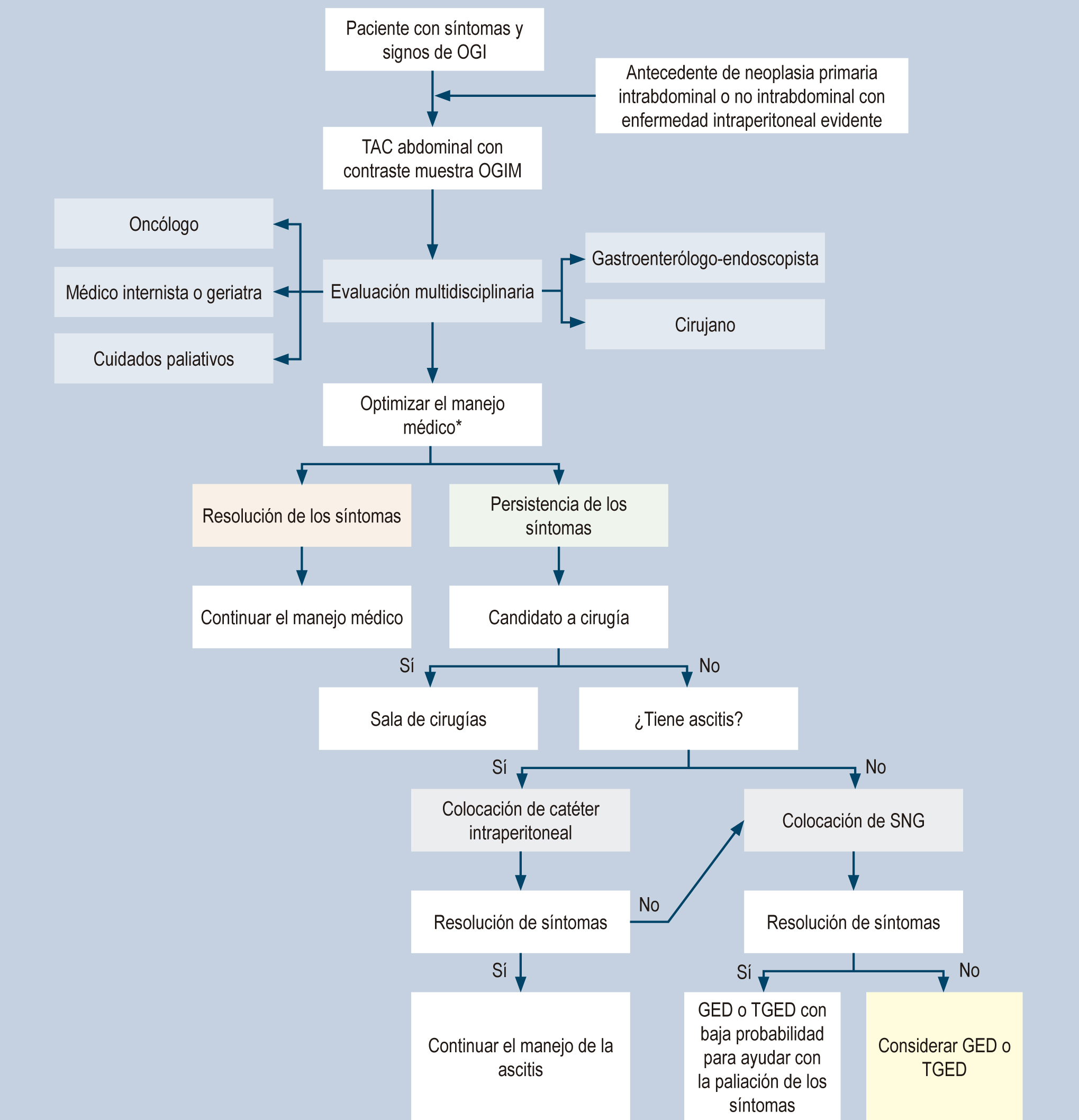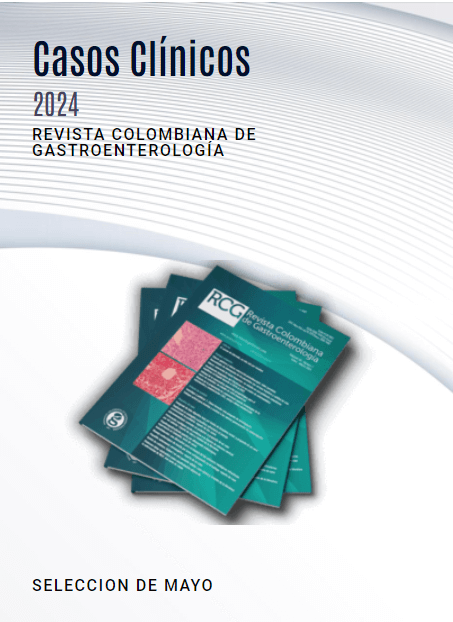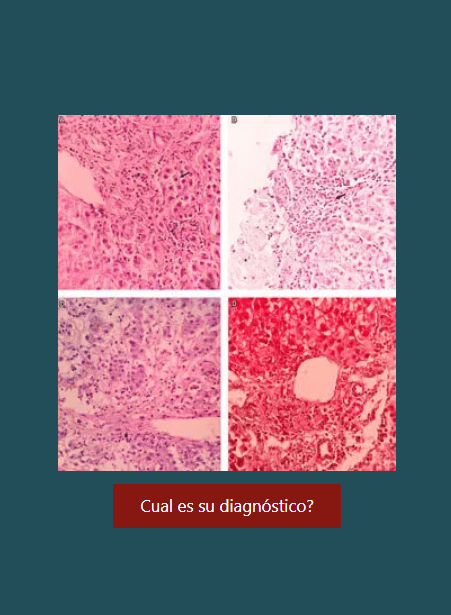Decompressive gastrostomy in patients with malignant gastrointestinal obstruction. Case report and literature review
DOI:
https://doi.org/10.22516/25007440.635Keywords:
Neoplasm, Malignant bowel obstruction, Decompressive gastrostomyAbstract
In recent years, decompressive gastrostomy has emerged as a therapeutic option for people with terminal cancer who experience intestinal obstruction without an initial surgical indication and refractory to medical treatment. The objective is to provide a better quality of life by restoring the oral route. Its contraindications have varied over time; however, new techniques have allowed broadening the spectrum of indications for this procedure. It has been reported that this technique supports symptom control and allows the return of the patients to their place of care. It could also allow restarting the oral route in order to maintain quality of life.
Downloads
References
Lilley EJ, Scott JW, Goldberg JE, Cauley CE, Temel JS, Epstein AS, et al. Survival, Healthcare Utilization, and End-of-life Care Among Older Adults With Malignancy-associated Bowel Obstruction: Comparative Study of Surgery, Venting Gastrostomy, or Medical Management. Ann Surg. 2018;267(4):692-699. https://doi.org/10.1097/SLA.0000000000002164
Laval G, Marcelin-Benazech B, Guirimand F, Chauvenet L, Copel L, Durand A, et al. Recommendations for bowel obstruction with peritoneal carcinomatosis. J Pain Symptom Manage. 2014;48(1):75-91. https://doi.org/10.1016/j.jpainsymman.2013.08.022
Miller ZA, Mohan P, Tartaglione R, Narayanan G. Bowel Obstruction: Decompressive Gastrostomies and Cecostomies. Semin Intervent Radiol. 2017;34(4):349-360. https://doi.org/10.1055/s-0037-1608706
Jacquet P, Jelinek JS, Steves MA, Sugarbaker PH. Evaluation of computed tomography in patients with peritoneal carcinomatosis. Cancer. 1993;72(5):1631-6. https://doi.org/10.1002/1097-0142(19930901)72:5<1631::aid-cncr2820720523>3.0.co;2-i
Berger J, Lester P, Rodrigues L. Medical Therapy of Malignant Bowel Obstruction With Octreotide, Dexamethasone, and Metoclopramide. Am J Hosp Palliat Care. 2016;33(4):407-10. https://doi.org/10.1177/1049909115569047
Pujara D, Chiang YJ, Cormier JN, Bruera E, Badgwell B. Selective Approach for Patients with Advanced Malignancy and Gastrointestinal Obstruction. J Am Coll Surg. 2017;225(1):53-59. https://doi.org/10.1016/j.jamcollsurg.2017.04.033
Krouse RS. Malignant bowel obstruction. J Surg Oncol. 2019;120(1):74-77. https://doi.org/10.1002/jso.25451
Tuca A, Guell E, Martinez-Losada E, Codorniu N. Malignant bowel obstruction in advanced cancer patients: epidemiology, management, and factors influencing spontaneous resolution. Cancer Manag Res. 2012;4:159-69. https://doi.org/10.2147/CMAR.S29297
Henry JC, Pouly S, Sullivan R, Sharif S, Klemanski D, Abdel-Misih S, et al. A scoring system for the prognosis and treatment of malignant bowel obstruction. Surgery. 2012;152(4):747-56; discussion 756-7. https://doi.org/10.1016/j.surg.2012.07.009
Mirensky TL, Schuster KM, Ali UA, Reddy V, Schwartz PE, Longo WE. Outcomes of small bowel obstruction in patients with previous gynecologic malignancies. Am J Surg. 2012;203(4):472-9. https://doi.org/10.1016/j.amjsurg.2011.07.013
Chakraborty A, Selby D, Gardiner K, Myers J, Moravan V, Wright F. Malignant bowel obstruction: natural history of a heterogeneous patient population followed prospectively over two years. J Pain Symptom Manage. 2011;41(2):412-20. https://doi.org/10.1016/j.jpainsymman.2010.05.007
Stellato TA, Gauderer MW. Percutaneous endoscopic gastrostomy for gastrointestinal decompression. Ann Surg. 1987;205(2):119-22. https://doi.org/10.1097/00000658-198702000-00002
Anthony T, Baron T, Mercadante S, Green S, Chi D, Cunningham J, et al. Report of the clinical protocol committee: development of randomized trials for malignant bowel obstruction. J Pain Symptom Manage. 2007;34(1 Suppl):S49-59. https://doi.org/10.1016/j.jpainsymman.2007.04.011
Mudumbi SK, Leonard EV, Swetz KM. Challenges and successes in non-operative management of high-grade malignant bowel obstruction. Ann Palliat Med. 2017;6(Suppl 1):S95-S98. https://doi.org/10.21037/apm.2017.03.07
Koo D, Goring T, Pinard K-A, Egan B. Malignant bowel obstruction in advanced cancer. Hosp Med Clin. 2016;5(3):413-24. https://doi.org/10.1016/j.ehmc.2016.02.005
Feuer DJ, Broadley KE. Corticosteroids for the resolution of malignant bowel obstruction in advanced gynaecological and gastrointestinal cancer. Cochrane Database Syst Rev. 2000;2000(2):CD001219. https://doi.org/10.1002/14651858.CD001219
Suárez Pérez A. Alimentación del paciente de cáncer en fase avanzada y terminal: consideraciones éticas y recomendaciones prácticas. Humanidad Med. 2006;6(2):1-9.
Scheidbach H, Horbach T, Groitl H, Hohenberger W. Percutaneous endoscopic gastrostomy/jejunostomy (PEG/PEJ) for decompression in the upper gastrointestinal tract. Initial experience with palliative treatment of gastrointestinal obstruction in terminally ill patients with advanced carcinomas. Surg Endosc. 1999;13(11):1103-5. https://doi.org/10.1007/s004649901182
Itkin M, DeLegge MH, Fang JC, McClave SA, Kundu S, d’Othee BJ, et al. Multidisciplinary practical guidelines for gastrointestinal access for enteral nutrition and decompression from the Society of Interventional Radiology and American Gastroenterological Association (AGA) Institute, with endorsement by Canadian Interventional Radiological Association (CIRA) and Cardiovascular and Interventional Radiological Society of Europe (CIRSE). Gastroenterology. 2011;141(2):742-65. https://doi.org/10.1053/j.gastro.2011.06.001
Levin DC, Matteucci T. “Turf battles” over imaging and interventional procedures in community hospitals: survey results. Radiology. 1990;176(2):321-4. https://doi.org/10.1148/radiology.176.2.2367646
Silas AM, Pearce LF, Lestina LS, Grove MR, Tosteson A, Manganiello WD, et al. Percutaneous radiologic gastrostomy versus percutaneous endoscopic gastrostomy: a comparison of indications, complications and outcomes in 370 patients. Eur J Radiol. 2005;56(1):84-90. https://doi.org/10.1016/j.ejrad.2005.02.007
Hoffer EK, Cosgrove JM, Levin DQ, Herskowitz MM, Sclafani SJ. Radiologic gastrojejunostomy and percutaneous endoscopic gastrostomy: a prospective, randomized comparison. J Vasc Interv Radiol. 1999;10(4):413-20. https://doi.org/10.1016/s1051-0443(99)70058-8
Campagnutta E, Cannizzaro R. Percutaneous endoscopic gastrostomy (PEG) in palliative treatment of non-operable intestinal obstruction due to gynecologic cancer: a review. Eur J Gynaecol Oncol. 2000;21(4):397-402.
Pinard KA, Goring TN, Egan BC, Koo DJ. Drainage Percutaneous Endoscopic Gastrostomy for Malignant Bowel Obstruction in Gastrointestinal Cancers: Prognosis and Implications for Timing of Palliative Intervention. J Palliat Med. 2017;20(7):774-778. https://doi.org/10.1089/jpm.2016.0465
Dittrich A, Schubert B, Kramer M, Lenz F, Kast K, Schuler U, et al. Benefits and risks of a percutaneous endoscopic gastrostomy (PEG) for decompression in patients with malignant gastrointestinal obstruction. Support Care Cancer. 2017;25(9):2849-2856. https://doi.org/10.1007/s00520-017-3700-1
Pothuri B, Montemarano M, Gerardi M, Shike M, Ben-Porat L, Sabbatini P, et al. Percutaneous endoscopic gastrostomy tube placement in patients with malignant bowel obstruction due to ovarian carcinoma. Gynecol Oncol. 2005;96(2):330-4. https://doi.org/10.1016/j.ygyno.2004.09.058
Ryan JM, Hahn PF, Mueller PR. Performing radiologic gastrostomy or gastrojejunostomy in patients with malignant ascites. AJR Am J Roentgenol. 1998;171(4):1003-6. https://doi.org/10.2214/ajr.171.4.9762985
Shaw C, Bassett RL, Fox PS, Schmeler KM, Overman MJ, Wallace MJ, et al. Palliative venting gastrostomy in patients with malignant bowel obstruction and ascites. Ann Surg Oncol. 2013;20(2):497-505. https://doi.org/10.1245/s10434-012-2643-5
Zucchi E, Fornasarig M, Martella L, Maiero S, Lucia E, Borsatti E, et al. Decompressive percutaneous endoscopic gastrostomy in advanced cancer patients with small-bowel obstruction is feasible and effective: a large prospective study. Support Care Cancer. 2016;24(7):2877-82. https://doi.org/10.1007/s00520-016-3102-9

Downloads
Published
How to Cite
Issue
Section
License
Aquellos autores/as que tengan publicaciones con esta revista, aceptan los términos siguientes:
Los autores/as ceden sus derechos de autor y garantizarán a la revista el derecho de primera publicación de su obra, el cuál estará simultáneamente sujeto a la Licencia de reconocimiento de Creative Commons que permite a terceros compartir la obra siempre que se indique su autor y su primera publicación en esta revista.
Los contenidos están protegidos bajo una licencia de Creative Commons Reconocimiento-NoComercial-SinObraDerivada 4.0 Internacional.


| Article metrics | |
|---|---|
| Abstract views | |
| Galley vies | |
| PDF Views | |
| HTML views | |
| Other views | |
















